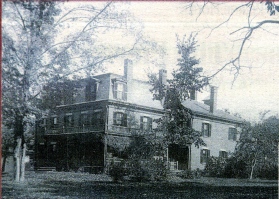History
The Pierce House, originally, The Farmington Home for Aged People, was incorporated by the state of Maine in 1905, with a bank balance of only $7.
Today, The Pierce House belies its modest beginnings. Arguably the most handsome and distinguished house on Farmington’s Main Street, it is set comfortably back from the sidewalk behind tall trees, a well tended garden and lush shrubs. The brick house sports a distinctive Mansard roof, added during an early modernization project. A long wing added more recently mimics the earlier design.
The main entrance is behind The Pierce House where there is an expansive lawn complete with patio, umbrella tables and chairs, raised beds of flowers, and a gazebo.
The house was one of the few survivors of the fire of 1886, which destroyed much of downtown Farmington, including the Baptist Church next door. The Pierce House sits between downtown Farmington and the campus of the University of Maine at Farmington. Residents of the home are a short walk away from the post office, banks, and churches. If they prefer to watch the activities along Main Street, or a passing parade, they can do so from a spacious, enclosed, and heated front porch.
The comfort and security of The Pierce House is the result of the forethought of those trustees who incorporated 100 years ago. That list of 26 names reads like a “Who’s Who of Farmington families. The founders were: Julia Butler, Lydia P. Holley, Anna B. Austin, Henrietta W. Brown, J.P. Thwing, H.M. Thwing, Austin Reynolds, Luella Reynolds, Benjamin Goodwin, Nancy Goodwin, Susan E. Smith, Orrah Jennings, Charles H. Pierce, Ella C. Pierce, Harriet P. Keyes, S.C.B. Ramsdell, Belle Gillman, Anna Butterfield, H. Herbert Rice, Ida M. Rice, S. C. Belcher, Ella O. Belcher, John T. Linscott, Chester Greenwood, and Isabele W. Greenwood.
Click to download slide show
Special People to Remember
Henrietta Whittier Brown - Founder and First President of the Board of Trustees. She had been the first to promote the idea of a home for the aged. A successful businesswoman with a dressmaker shop in New Sharon, then in Farmington Falls, she closed her shop to care for her ailing mother. In all she had cared for seven aged or sick relatives, according to her obituary. Brown had first hand knowledge of the need for such a facility. A woman of action, she made the first donation of $ 1.00 to the organization.
Contemporary reports say that the group spent $1.00 for advertising, which gleaned a donation of $2.00 in 1903 from Hattie S. Cabot of Weehawken, N.J. and one of $5.00 in 1905 from Frank Whittier of San Francisco.
Belle Wright Gillman – Vice President of the new organization. Belle Wright Gillman was the wife of Samuel Gillman. After his death Belle went to France to study painting. Back in Farmington, she purchased several tracts of land, covered with beech trees, near the lower crest of Anson Street. There, in 1888, she built a turreted Victorian house, still standing, which she dubbed Beechwood. The home and gardens are currently owned by the Etzel family and are immaculately maintained. Mrs. Gillman deeded that property in 1911 to The Farmington Home for Aged People for its first home. It was not meant to be, because the trustees decided that the location was not as desirable as the present location in downtown Farmington.
General Edmund Hayes –Offered a $25,000 matching grant for start-up costs and it was eventually matched. General Hayes was a graduate of the Farmington Normal School; he attended Dartmouth College, then left to go to MIT where he graduated. An engineer – the “General” title was an honorary title – and he always remembered Farmington fondly.
Robert Goodenow – Built the original house in 1835. Mr. Goodenow was an influential Farmington attorney and had the distinction of being the last Whig from Maine’s Second District to serve in Congress.
Daniel William Austin – Purchased the Goodenow mansion in 1885. Mr. Austin and family enlarged the home after they moved back to Farmington from New York where they may have gotten the idea to “modernize” the house with the then fashionable Mansard roof.
Charles Harlow Pierce – Purchased the home in 1907, after renting the residence for almost a year. Mr. Pierce moved his family from the farm on the Sandy River to the village of Farmington in 1894. He became tax collector in 1891, a position he held for 38 years. Mr. Pierce was on the Board of Trustees of the Peoples Trust Company, became a director when the company became Peoples National Bank, and then in 1928 succeeded George M Currier and President. He was made Chairman of the Board, an honorary position when he retired.
Mr. Pierce married Ella C. Perkins of Chesterville. They had four children, only one of whom, Elsie, survived him. Elsie married Jarvis L. Tyler and they had two children, Maxine, who married G. L. Ibarguen, and Robert, who married Agnes Webber.
Click here to read more on Charles Harlow Pierce.
Excerpts from the Special Supplement, Morning Sentinel, June 28, 2005; M.J. Kaniuka, Correspondent.
 207-778-4745
207-778-4745